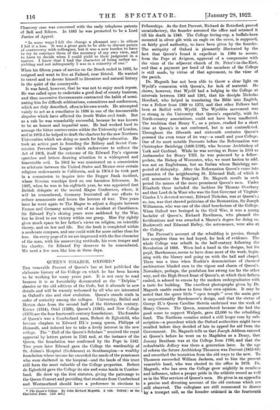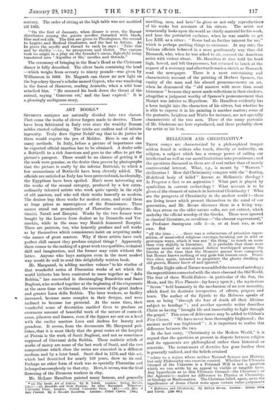QUEEN'S COLLEGE, OXFORD.* Tan venerable Provost of Queen's has at
last published the elaborate history of his College en which he has been known to be working for many years past. It is not easy to read because it is as formidably dccumented as the " Delphin " classics or the old editions of the Code, but it abounds in new details and will be warmly welcomed by all who are interested in Oxford's rise and slow evolution. Queen's stands sixth in order of seniority among the colleges. University, Balliol and Merton date from the second half of the thirteenth century. Exeter (1314), Oriel (1326), Queen's (1341), and New College (1379) are the four fourteenth-century foundations. The founder of Queen's was a Cumberland man, Robert de Eglesfield, who became chaplain to Edward III's young queen, Philippa of Hainault, and induced her to take a lively interest in the new college. The " Hall of the Queen's Scholars " received the royal approval by letters patent in 1341 and, at the instance of the Queen, the foundation was confirmed by the Pope in 1342. Two years later Edward gave the College the wardenship of St. Julian's Hospital (Gcdshouse) at Southampton—a wealthy foundation whose income far exceeded the needs of the pensioners who were sheltered in the hospital—and the lands of this trust still form the most valuable of the College properties. Robert de Eglesfield gave the College its site and some lands in Cumber- land. He drew up the first statutes, giving the patronage to the Queen-Consort and providing that students from Cumberland and Westmorland should have a preference in elections to
• The Queen's College. By John Richard Magrath. 2 vols. Oxford : at the Clarendon Pres. 1423 meld Fellowships. As the first Provost, Richard de Retteford, proved unsatisfactory, the founder assumed the office and retained it till his death in 1349. The College loving-cup, a buffalo-horn mounted in silver gilt with an eagle on the cover, is supposed, on fairly good authority, to 'have been given by the founder. The antiquity of Oxford is pleasantly illustrated by the fact that Queen's found it expedient in 1364 to secure, from the Pope at Avignon, approval of a compromise with the vicar of the adjacent church of St. Peter's-in-the-East, and that a payment per head of the members of the College is still made, by virtue of that agreement, to the vicar of the parish.
Dr. Magrath has not been able to throw a clear light on Wyclifs connexion with Queen's, for lack of material. He shows, however, that Wyclif had a lodging in the College at intervals between 1363 and 1381, that his disciple Nicholas Hereford, who helped in translating the Bible into English, was a Fellow from 1369 to 1375, and that other Fellows had been at Balliol- with Wyclif. The Wyclifite movement was so strong in the University that Queen's especially, with its North-country associations, could not have been unaffected. The tradition that Henry V., as a prince, studied for a short time at Queen's is not confirmed, but is not contradicted. Throughout the fifteenth and sixteenth centuries Queen's pursued the even tenor of its way—a small and poor College. One of its most notable Provosts before the Reformation was Christopher Bainbrigg (1496-1008), who became Archbishop of York and Cardinal. While he was serving at Rome in 1514 as Ambassador for Henry VIIL he was poisoned by a fellow- prelate, the Bishop of Worcester, who, we must hasten to add, was not an Englishman, but an Italian whom Bainbrigg sus- pected of disloyalty. After the Reformation Queen's came into possession of the neighbouring St. Edmund Hall, of which it still nominates the Principal. Dr. Magrath recalls in each period the names of the more prominent Queen's men. Under Elizabeth these included the luckless Sir Thomas Overbury and that Lord de la Warr who was the first Governor of Virginia. Charles I.'s devoted servant, Edward Nicholas, was at Queen's ; so, too, was that shrewd politician of the Restoration, Sir Joseph Williamson, who was one of the chief benefactors of the College. When Oxford was besieged in the Civil War, it was a young bachelor of Queen's, Richard Rawlinson, who planned the fortifications and was awarded a Master's degree for doing so. Rushworth and Edmund Halley, the astronomer, were also at the College.
The Provost's account of the rebuilding is precise, though less complete than we had hoped, for lack of evidence. The whole College was rebuilt in the half-century following the Revolution of 1688. Wren had a hand in the designs, but his pupil, Hawksmoor, seems to have done most of the work, begin- ning with the library and going on with the hall and chapel. There was a time when Ruskin's denunciations of classical architecture blinded men to the vigour and charm of Queen's. Nowadays, perhaps, the pendulum has swung too far the other way, and the High Street front of Queen's, at which their fathers smiled, is adored to excess by the modern undergraduates with a taste for building. The excellent photographs given by Dr. Magrath enable readers to form their own opinion. It may be noted that the queer little " open temple " over the main gate is unquestionably Ilawksmoor's design, and that the statue of George II.'s Queen Caroline therein enshrined was the work of Henry Cheere. The Queen, remembered because she had the good sense to support Walpole, gave £2,000 to the rebuilding fund. The Northern counties raised a still larger sum by sub- scription—a precedent which the Oxford authorities might have recalled before they decided of late to appeal for aid from the Government. Dr. Magrath tells us that Joseph Addison entered at Queen's before he went on to Magdalen as a Demy, that Jeremy Bentham was at the College from 1760, and that the redoubtable Jeffrey was there a generation later. In the age of reform the future Archbishop Thomson was Provost (1855-62) and smoothed the transition from the old ways to the new. To Thomson succeeded William Jackson, and to him the present venerable head, who was elected to the office in 1878. Dr. Magrath, who has seen the College grow mightily in numbers and influence, takes a proper pride in the athletic record as well as in the War services of Queen's men. He gives in an appendix a precise and diverting account of the old customs which are still observed.. The collegians are still summoned to dinner by a trumpet call, as the founder ordained in the fourteenth
century. The order of sitting at the high table was not modified till 1865.
" On the first of January, when dinner is over, the Bursar distributes among the guests needles threaded with black, blue and red silk. The first are given to Theologians, the second to Legists and Medical Graduates, and the last to Artists. As he gives the needle and thread to each he _says : ' Take this and be thrifty '—i.e. be prosperous and thrive. The custom took its origin in a play on the founder's name, Eglesfield being translated into Aiguilles et fits,' needles and threads."
The ceremony of bringing in the Boar's Head at the Christmas dinner is fully described. The silver basin containing the head —which weighs from seventy to ninety pounds—was given by Williamson in 1668. Dr. Magrath can throw no new light on the legendary Queen's scholar named Copcot, who was wandering in the forest of Shotover, reading Aristotle, when a wild boar attacked him. " He rammed his book down the throat of the animal, saying Graecum eat,' and the boar expired." It is a pleasingly ambiguous story.



































 Previous page
Previous page